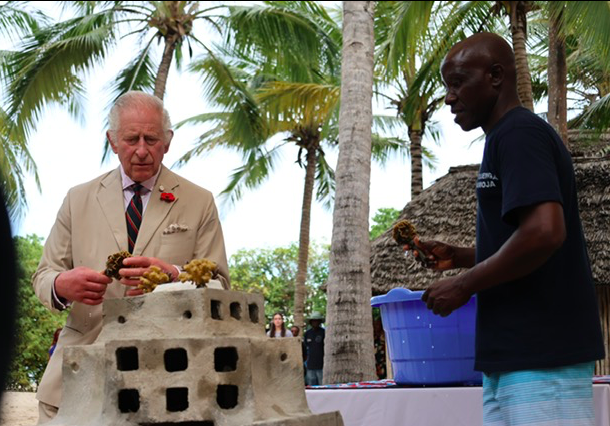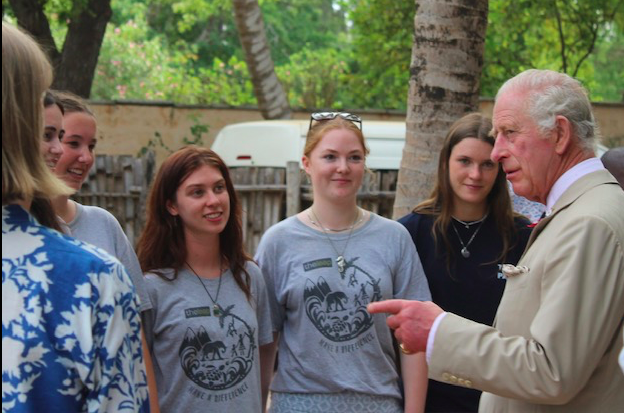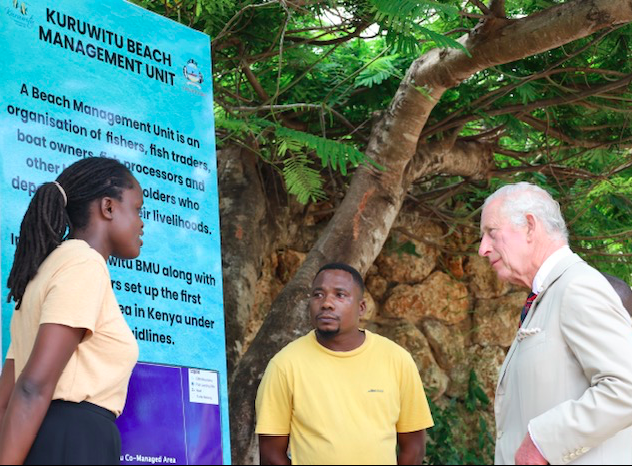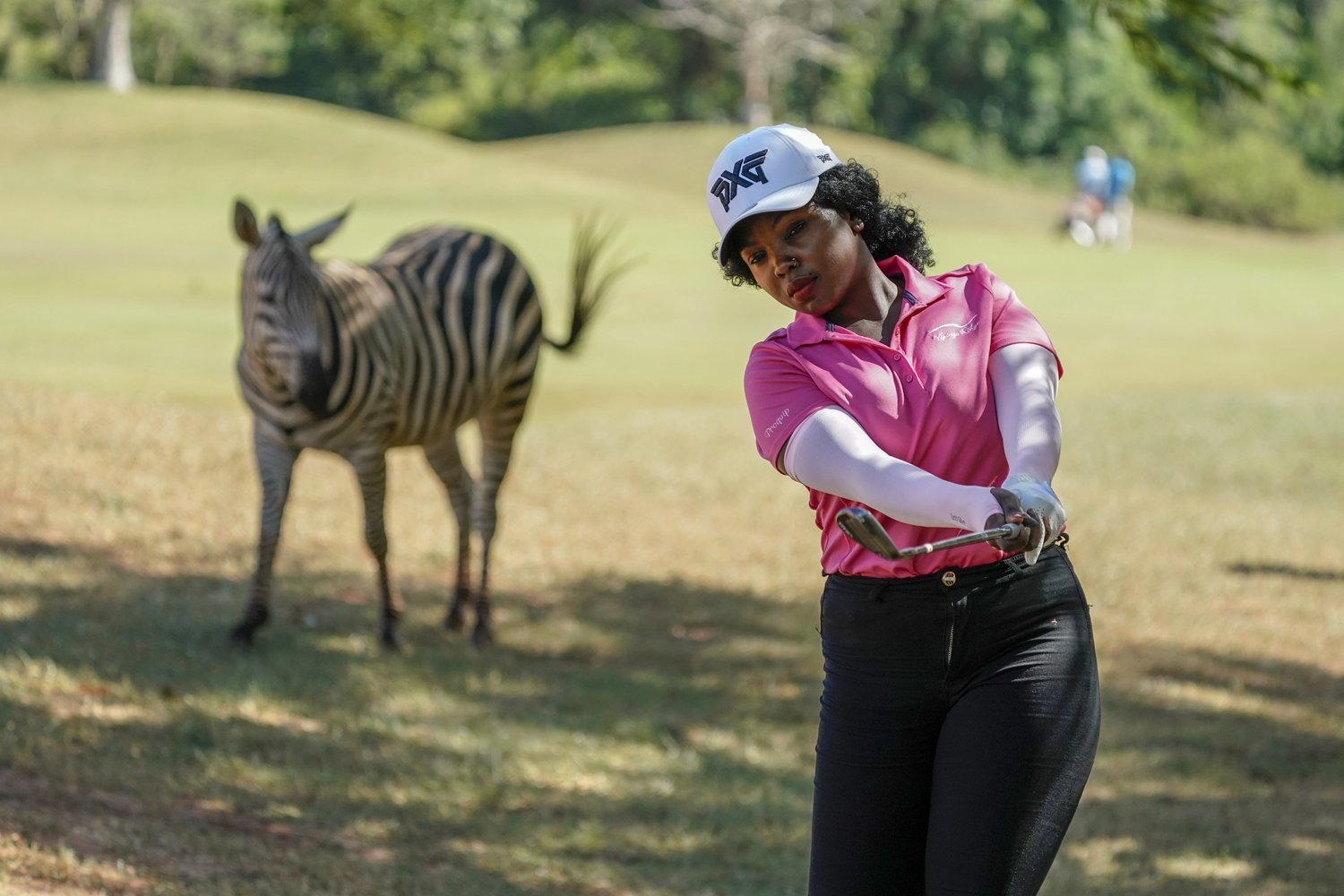Behind the scenes: the anatomy of a Royal Visit
The second guest blog in our series with partner Oceans Alive Trust. This candid piece by Education Director Tilda Bowden gives unique insight in the visit by His Majesty King Charles II to Kuruwitu, the Vipingo Ridge Beach Club and the ongoing impact of the marine conservation and community work of the trust and the Kuruwitu Community Business Organisation (CBO). We thank Tilda for sharing her behind the scenes experience of a Royal Visit.
By Tilda Bowden
It started with an after-hours call; would we show the new British High Commissioner, Neil Wigan OBE, around the project the following morning. We were of course honoured to host such an important dignitary, but with such little notice, we could do little to prepare, other than put our best, and often bare, foot forward.
We all pulled together to put together the semblance of a decent tour of the office and a snapshot of our work.
The reconnaissance visit
The police car came first, then a cavalcade of assorted vans and cars arrived shortly afterwards. The High Commissioner was accompanied by his Deputy, Josephine, and a surprising number of Kenyan and British security. It became clear almost immediately that this wasn’t an ordinary visit.
The team kept referring to the ‘Visitor’ and the size of the advanced planning team from Buckingham Palace pointed to a senior member of the Royal family. Who could it be, we wondered?
Being chosen as a ‘serial’ in the upcoming tour
Over the next few weeks, the British High Commission asked for increasing levels of detail and visited us a few more times.
On one visit, I was taken aside and told what we already suspected: the King was coming to visit. It seemed impossible and more than slightly surreal and with no other news of an imminent Royal visit to Kenya, we just had to carry on as usual.
Preparations for the Royal Visit
The visit was to both Oceans Alive and Kuruwitu Conservation and Welfare CBO, which Des and Dickson Juma first set up in 2003. The Beach Management Unit (BMU) are a vital part of our wider team, so they were also included.
Keeping the identity of ‘the Visitor’ as quiet as possible didn’t make it any easier to get the team to take it seriously. I sometimes wondered myself if the visit would really happen.
The key messaging
As a team, we discussed key messages and how best to convey our work's information-heavy and sometimes complicated nature.
Our Environmental impact projects, such as coral restoration, Social and Economic permaculture and alternative livelihoods are quite easy to explain and demonstrate.
The importance of Education - awareness and importance of conservation for local school children, gap year, students and interns is also straightforward.
However, the Governance aspect is the hardest to explain, and yet a critical component of our work.
Leading the region’s first Collaborative Area and Plan
The Co-Management Plan was completed just after COVID-19 after five years of work. The plan covers 12,000 hectares (roughly 120 sq km) of coastline, putting this vast area under Co-Management. Ratified by the County Government in 2021, the plan is set to change the management and use of marine and coastal resources.
It has been a considerable undertaking, and while it is not visible like our impact projects, it can make a massive difference to the whole of Kilifi County, if not the country. When we're asked what we do, we struggle with how to explain this part of our work though the impact is far reaching.
Working together with Vipingo Ridge
Meanwhile, planning for the visit continued, with scarcely a week going by without someone else needing to see a specific aspect of the trip.
One of the critical early visits was with the Vipingo Ridge team. I was able to walk and talk them through my concerns and issues as ‘the Visit’ became a reality. The team took these on and developed a full schedule of plans and improvements across the site we share that would make a real difference.
All of the small site challenges were underway. Lighting, layouts, drainage, equipment, roofing, signage and tidying were in full and fast motion. The gate to the Beach Club from the barely dry tarmac was reangled and replaced with a new entrance. A new gate and pathway were put in from the Oceans Alive garden to the Vipingo Ridge Beach Terrace. The gardening workforce mobilised, pruned and planted, while the Vipingo Ridge leadership stayed on top of it all and gave me great hope that 'it' – and there was a lot of it – would happen.
Final preparations
Weekly walk-throughs now became almost daily – security teams, press positions, water points, loo stops, protocol and wet weather plans were all discussed in detail from practically every angle.
The week and days before the visit were a blur; so many details that had been in play for months and weeks were finally coming together. Stress levels were high, yet the Vipingo Ridge team kept coming up with solutions, action and a much-needed injection of calm.
Interactive Focal Point
The focal point of the King's visit would be planting a coral plug in a commemorative structure which would be launched into the sea with His Majesty's cypher featured on the coral structure.
Ready to welcome His Majesty
As the day drew nearer, the Kenya Police became a daily and reassuring presence. They promised to secure the beach and the road and ensure the whole area was safe.
Everyone in the office was busy, working superfast. Floors were being re-mopped, the mural was being finished, and everywhere, people were intent on phones and screens. Then I got a call to say the Kilifi Governor was also joining. Fantastic news of course and we adapted to accommodate His Excellency as well as His Majesty.
Step 1 – the Welcome
We had a moment to breathe before the extraordinary sound of multiple police sirens and over 30 vehicles arriving told us what we all wanted to know: He had arrived.
The King was met at the office entrance by the Kilifi County Governor and Des who then introduced Area Chief Salome, co-founder Dickson Juma, and Kuruwitu-CBO Chair Maryam.
Inside the office, Des and Dickson answered the King's questions about the history of Kuruwitu-CBO and how it all started.
Step 2 – the Kitchen Gardens
The King was led through our demonstration garden, and the importance of food security and the link with marine conservation was explained.
Step 3 – the Beach Terrace
I waited at the Vipingo Ridge Beach Terrace for Dickson to introduce me to the King. and the next few minutes flew by as he asked questions and enjoyed Des’ underwater film.
Step 4 – the Beach
Des and Dickson led the King down the Beach Terrace stairs to the four stands set up along the terrace walk. The BMU, Women's Group, Education and Environment each had a stand and the team on each stand answered the King's questions and told their personal stories of the impact of our work.
Step 5 – the walk to the Coral workshop and coral planting
Katana Ngala met His Majesty next and led him across the beach bar to the Oceans Alive Coral Workshop. The King is well-informed about coral species and asked lots of questions about the restoration process. He was enthusiastic about the coral restoration structure we made for him and even helped plant live coral plugs into the structure before launching it into the sea.
Step 6 – the Shore
The Royal party then went to the seashore and the King met with Elders led by former Chief David Kahindi. They told stories of the changes they had seen over the decades at Kuruwitu, and the King spent time listening and asking pertinent questions.
Katana led the King to the sea's edge, and they watched the specially branded coral structure as it was launched into the marine protected area. It was a special moment.
Step 7 – the Farewell
The next stop was the exit and the waiting Royal car. However, despite the heat, his Majesty stopped to chat with our Leap gap year students from the UK and the US. The King talked passionately about the importance of marine conservation, particularly marine protected areas. The students were overawed entirely and said it was the best day of their lives.
The King waved and was quite suddenly gone. The sirens and dust of the departing convoy did not dampen the 'glow' moment: we had done it – the visit to Kuruwitu was a success.
Reflecting on the Visit
We watched highlights later on YouTube and saw how relaxed the King looked.
He impressed us all with his humour and understanding and a genuine and deep interest in conservation and community.
We must now continue our work. We have promised the King to nurture his coral structure, but also to continue the work which started twenty years ago when Des and Dickson first began to talk about what they could do to protect and restore the sea in balance with the needs of the community.
Looking back to those formative conversations in a small village in Kuruwitu, no one would have believed the journey we have been on.
Our work has developed and grown, and as we enter our third decade, we aim to extend the impact of our work further and ensure that whoever visits us in the future, the safari will continue and that our conservation projects at Kuruwitu and beyond are fit for Kings and Queens - and most importantly our coastal community.







